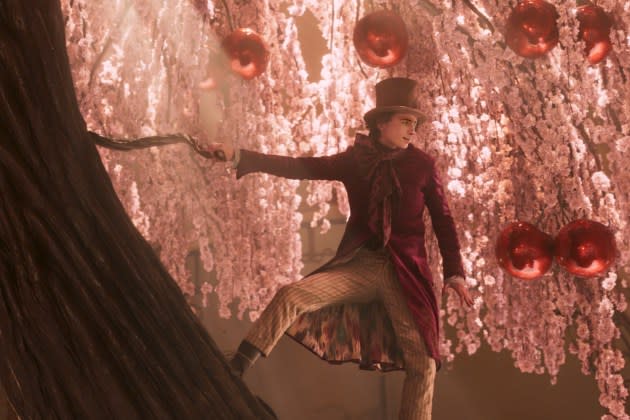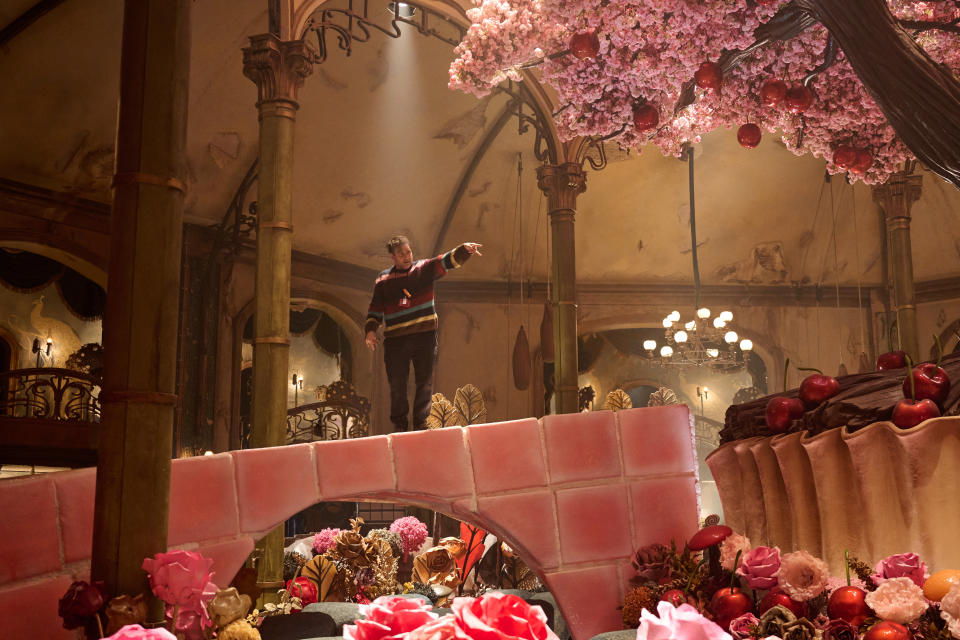‘Wonka’ Production Designer on Building a Whimsical City Based on Nostalgia: ‘You Can Connect With an Audience That Way’

Four-time Academy Award nominee Nathan Crowley grew up in England with his mother reading Roald Dahl stories to him. So he reached a full circle moment when, decades later, he was asked to serve as the production designer on Paul King’s “Wonka,” which offers a heartwarming origin story for Dahl’s iconic chocolatier.
“Obviously, the film when I was a young kid was unbelievable — Gene Wilder!” Crowley tells Variety. “How old was I, seven? It was just magic. It was part of my youth. So to get to do a ‘Wonka’ film, why wouldn’t you do that?”
More from Variety
Box Office: Timothée Chalamet's 'Wonka' Surpasses $150 Million Globally
Timothée Chalamet's 'Wonka' Tops Box Office With $39 Million Debut
In “Wonka,” the eccentric candymaker is not yet the jaded success story audiences know from “Charlie and the Chocolate Factory,” in which he teaches brutal lessons to spoiled children. Willy (Timothée Chalamet) is just starting his career and has the singular goal of realizing his childhood dream of making and sharing chocolate with the world — an aspiration he expressed to his mother before she died.
In conversation with Variety, Crowley breaks down the complex production design process, in which he and his team conceptualized and executed the vision for the film’s whimsical, magical settings — most of which involved limited VFX. From a chocolate shop with giant sculpted plants to a quaint town square amalgamating various European cities, “Wonka”’s visual landscape embodies the distinct charm of a comforting holiday classic.
While King, Crowley and his team would typically wander locations in pursuit of inspiration, the scouting process commenced during Covid-19 lockdown — so they turned to Google to virtually explore European locales. However, they didn’t settle on any particular city where the story should unfold.
“You conclude that you kind of want to build your own place because you’re trying to achieve, as I call it, ‘Roald Dahl realism,’ which is fantasy but on all his terms,” Crowley explains.
He continues, “The Galerie Gourmet is the heartbeat of chocolate making and confectionery so you have to build out this town. So I start big, like, ‘Where? What is the town like?’ There were lots of references like Bruges Bell — the bell in Brussels — Ghent, Milan, a lot of towns in France, Switzerland, you’re wandering around even Georgian London…I call it the best of Europe.”

Crowley explains that he built sets up to 35 feet high on backlots; filming was divided between those constructed sets and on-location shooting across Europe, which he says allowed the audience to escape a sense of claustrophobia.
He continues to detail how Willy’s story came to take place in a fantastical city that borrows architectural details from all around the continent — a strategy that also has an emotional underpinning to it.
“I love the whimsical hand-painted windows of Prague, and I want to mix them with Georgia and London — how do we do that? Like, let’s try a series of colonnades!” he says. “If you feel your way through it, I think you can touch on everyone’s nostalgia for place. And you can connect with an audience that way, I can connect through the architecture because everyone has a weird, odd memory — wherever you’ve been that presses on your memory in Europe, there’s a bit of that in the film.”
The design for Willy’s first chocolate shop was also rooted in nostalgia — the character’s nostalgia for his childhood.
Crowley says, “It’s a memory of his childhood that he was most happy in with his mother, and you translate that into an edible shop, as his memory of his past. The most beautiful thing he can think of is that. So he wants the secret garden of his childhood in chocolate and sweets so that they have to connect.”

Crowley, set decorator Lee Sandales and prop master Jamie Wilkinson worked tirelessly with a team of builders and sculptors to fashion a spinning cherry blossom tree, a river of chocolate and lots of edible-looking plants — including giant cherries — to bring the colorful shop to life. This process came with a unique set of issues that only a Willy Wonka film might entail.
“Crazy problems, like how are we going to get Willy up to the base of the tree?…Let’s build a Turkish delight road to the tree. Well, how do we how do we make Turkish delight pavers that are squidgy?” Crowley says.
Later, in the film’s climactic moment, Willy and Noodle (Calah Lane) nearly die drowning in a tank of chocolate hidden in a secret lair beneath a church, accessible only via a confessional booth. The crew built an exterior for the church, then filmed interior scenes in London’s iconic St. Paul’s Cathedral — which, crucially, does not have confessional booths, so they built that pivotal set piece themselves. For the tank itself, Crowley was inspired by the baths of Budapest — since tile is more “romantic” than metal, he notes.
“We have meetings about chocolate thickness. Then it’s like, ‘Oh, yes, please, Timothée, would you get into the chocolate tank?’ It’s all mad, you know?” he says. “The connective tissue is complex to get everything you need. But the idea is you don’t ever question anything, you just go with it. That’s really the art — for us to go unnoticed in a weird way.”
Best of Variety
Sign up for Variety’s Newsletter. For the latest news, follow us on Facebook, Twitter, and Instagram.


